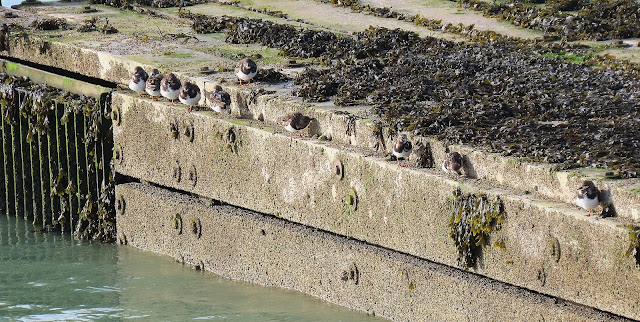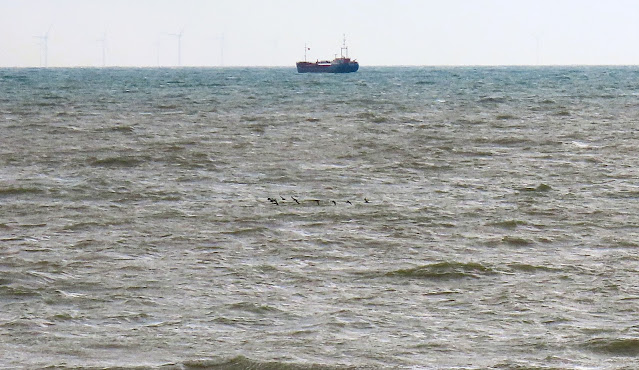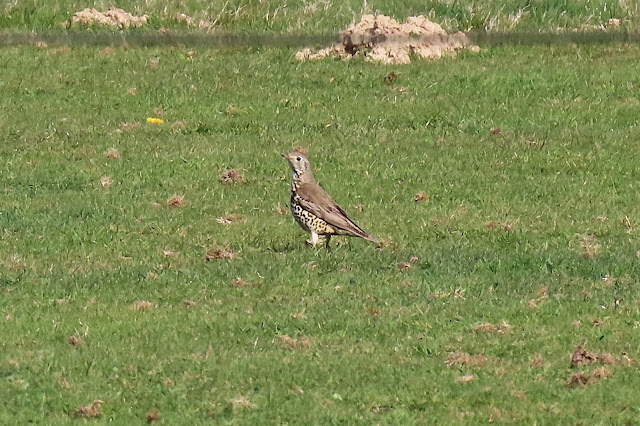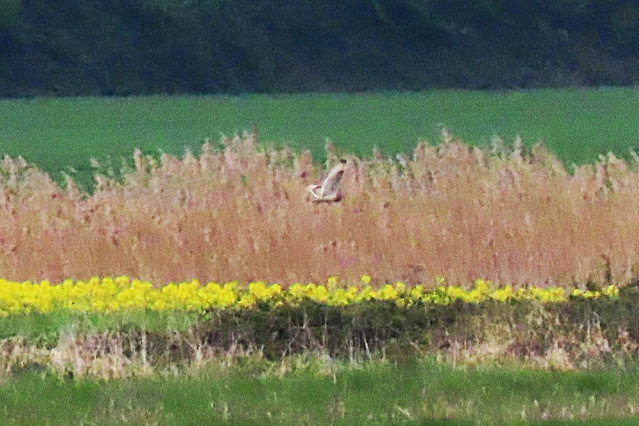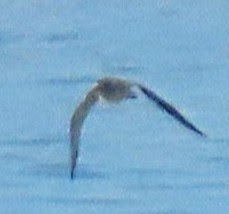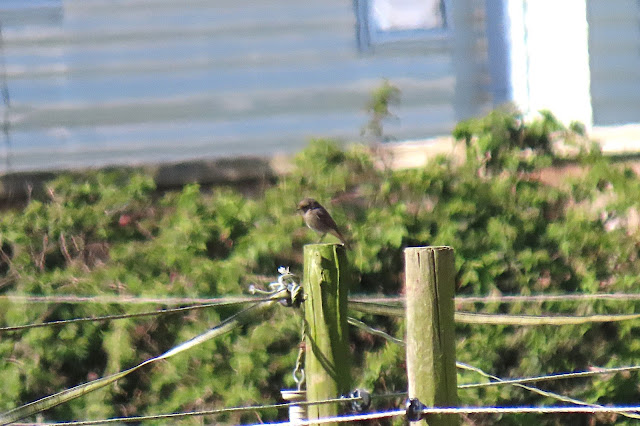Wednesday, 23rd April: Some heavy but welcome overnight rain lingered a bit but soon gave way to a cloudy and changeable morning with some sunshine and a moderate W breeze force 3-4. Mainly dry through the day, with just a few odd showers and the wind becoming variable later.
Bilsham farm: After a morning spent sea-watching at Selsey Bill - with very few rewards - I made a brief diversion to the reservoir area here, on my way back home early this afternoon....which also proved to be unrewarding and barely worth the effort! On the water were just four Little Grebes, two Tufted Ducks, a dozen Mallard, two Gadwall and 16 Coots, with several Swallows hawking above. Around the perimeter were four Linnets on the fence, plus three Blackcaps and four Whitethroats in the hedgerows.
Little Grebes on Bilsham reservoir - the highlight of a very quiet day here!
Tuesday, 22nd April: After some early cloud, a pleasant day of sunshine and calm conditions, with a fairly light NW breeze 2-3, backing SW 4 later.....but with the possibility of rain by late evening.
Elmer Rocks: Pleasant enough conditions and a calm sea this morning, but yet again there was very little offshore to suggest migration. I logged just Gannet 3E, Oystercatcher 9E, Mediterranean Gull 2E and two Great Crested Grebes on the sea. Gradually though, a few bits and pieces were added to make it a morning of some interest.
A group of 13 Turnstones were feeding on weed on top of the outfall pipe and amongst them was a Common Sandpiper which stayed a little while. A group of up to eight noisy Sandwich Terns appeared, fishing back and forth behind the rock islands, then a flock of 23 Sanderlings stopped off to rest and feed along the shore. A newly arrived Wheatear flew up from the beach, settling briefly on telegraph cables before heading off north, whilst two Swallows arrived north from the sea.
Moving away from the beach, a walk along the 'long hedge' area behind produced four Whitethroats and two pairs of Linnets - both of the latter seemed to be paired up and were carrying nesting materials. A pair of Buzzards were calling and displaying and several Blackcaps and Chiffchaffs were singing at times. The best though came as a real surprise...I was checking an uncultivated area, which is a dried and muddy/sandy patch surrounded by arable, just west of Poole Place, when I unexpectedly flushed a bird which gave a loud, clear, full descending burst of song....it was a Woodlark! There was no doubt - and I even had my hearing aids in! - but I could not re-find the bird and I was left to ponder on what had just happened...quite bizarre really, but clearly a migrant on the move.
At Elmer Rocks this morning: Common Sandpiper (above) followed by Linnet with nesting material, Wheatear, Turnstones on the outfall pipe and Sandwich Tern.
Elmer & Ancton: A brief look at the Lane End paddocks area didn't produce too much, the best being the regular Mistle Thrush which was collecting food and flying off, doubtless to feed young. The pair of Pied Wagtails were also still present, as were a couple of Swallows around the stables, whilst the woods behind held several Chiffchaffs and Blackcaps.
Mistle Thrush collecting food
Lidsey WTW area: There wasn't anything out of the ordinary, but I logged two Little Grebes, three Tufted Ducks, six Gadwall and 12 Mallard. A nice Grey Wagtail was back and forth and two Buzzards were showing a bit of display, with the regular warblers now in the hedgerows.
Easter Monday, 21st April: A fairly grey, dry and cool morning, quite murky, with hazy conditions offshore and a light SE breeze, veering more SW later.
Elmer Rocks: The sea was very calm but also hazy...it was a job to see the horizon at times, but there was very little on the move today. Up to six Great Crested Grebes were offshore, whilst two Gannets, a Grey Heron, five Brent Geese, two Shelduck and a handful of Sandwich Terns went east. A flock of five Oystercatchers dropped in to join another two on the beach, where six Turnstones and three Sanderlings were also present.
I had only casual looks at the sea as I walked along, while also checking the hedgerows and gardens, so likely missed some passage, but doubt there was much. Three Whitethroats were new in and singing; also a couple of Chiffchaffs and Blackcaps were heard, and two pairs of Linnets were courting and gathering nest materials.
Grey Heron heading east offshore from Elmer Rocks and singing Linnet, which seems to be paired up
Barnham Brooks, Lidsey/Shripney area: It was generally quiet when I visited here this morning, the highlight being two Little Ringed Plovers on what little remains of a flooded arable field, together with just 16 Teal, four Gadwall and a few Mallard, plus a few Lapwings. There were at least three Cetti's Warblers singing, but nothing beyond the normal, with a few Reed Warblers, a Sedge Warbler and the regular Whitethroats, Blackcaps and Chiffchaffs on site.
It was a hard job locating any waders this morning with most of the previously flooded fields having almost dried up; here a Little Ringed Plover is just about visible on the mud (centre).
Easter Sunday, 20th April: Cool, cloudy and grey, with rain most of the morning - albeit mainly light and spitty - in a fresh to strong NE wind 4-5/6. Gradually drying and brightening up by around noon, with sunny periods and the wind easing slightly.
Elmer Rocks (0745-1030hrs): The light rain was just heavy enough to be irritating but there was nothing for it but to stay sea-watching. The highlights for me were the four Little Terns that passed eastwards, reasonably close behind the rock islands, and a soggy, newly-arrived Wheatear that was grateful to land on the rocks after arriving from the sea. It was slow-going at times, but my log was as follows:
Gannet - 22E, 10W
Great Crested Grebe - 1 o/s
Bar-tailed Godwit - 7E
Turnstone - 6 o/b
Sanderling - 1 o/b
Little Tern - 4E
Common Tern - 1E
Sandwich Tern - 26E
Wheatear - 2
Linnet - 4 o/b
Goldfinch - 10
Newly arrived Wheatear at Elmer Rocks....made it!
Bilsham farm: The first Common Sandpiper at the reservoir this spring was present this morning, whilst on the water were 3 Little Grebes, a Great Crested Grebe, a Black Swan, 14 Mallard and six Gadwall, with three Swallows and two Sand Martins feeding above. Around the hedgerows three Whitethroats and a Yellowhammer were singing, and a pair of Swallows near the donkey paddocks looked as if they were paired up and likely to breed there.
Common Sandpiper (above), Black Swan and Great Crested Grebe on the reservoir, and Swallow near the donkey paddocks.


























